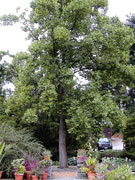


Home
Flowers &
Indoor Plants
Fruits & Nuts
Ornamentals
Vegetables
Special Topics
Resources
Glossary

Tuliptree, Tulip Poplar |
 |
What about it? The tuliptree is a large, deciduous tree of the Magnolia Family. It is native to North America and known as the tallest growing tree of the eastern woodlands. The foliage of the tuliptree is usually green but will turn yellow in the fall. In mid-June the tuliptree blooms greenish-yellow flowers. What is it used for?The tuliptree can be used for decoration, shade, or as a lawn tree. These trees are well-known for their straight trunks and furrowed bark. Where does it grow? How do we grow it? The tuliptree grows best in moist, fertile, well-drained soil. They should be spaced 50 feet apart when planting. What are its primary problems? Tuliptrees can be injured by aphids, leaf spot, and powdery mildew. Sooty mold often grows on the 'honeydew' secreted by aphids and scales. In general, these trees are not tolerant of air pollutants. If air quality is poor the wood becomes brittle.
© Copyright, Department of Horticulture, Cornell University. |









